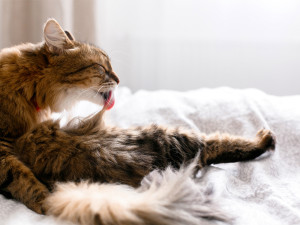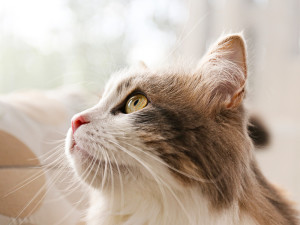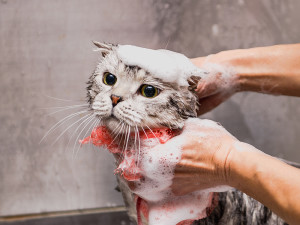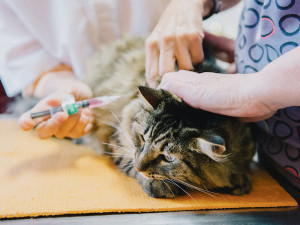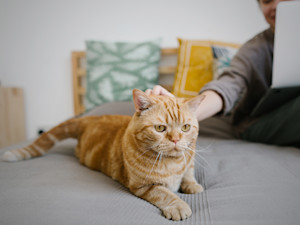How to Spot, Treat, and Prevent Hot Spots on Your Cat
Hot spots are so not hot—your cat agrees.
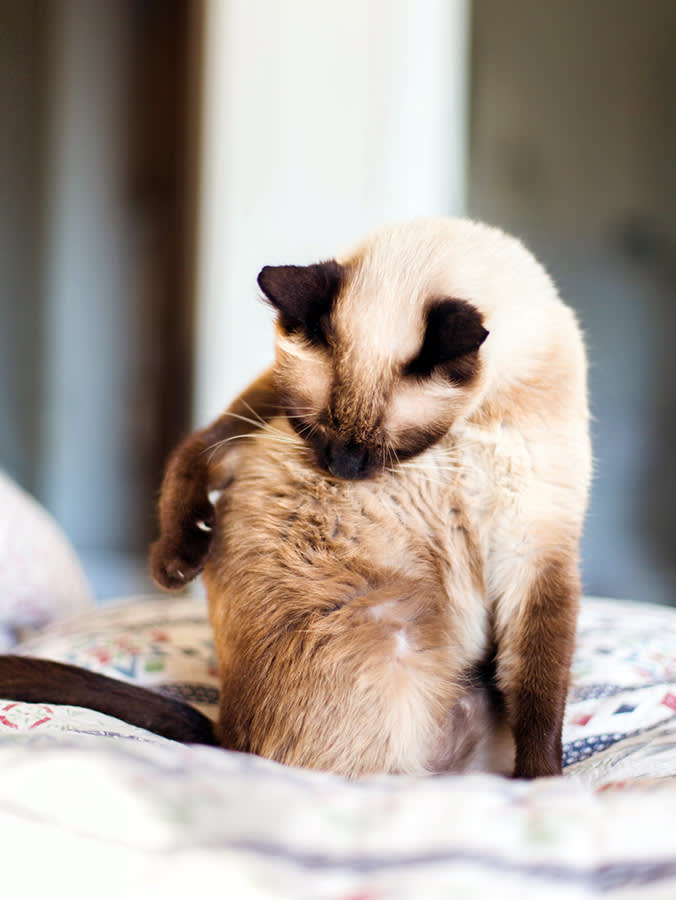
Share Article
In This Article:
What Are Hot Spots? What Causes Hot Spots on Cats? Symptoms of Hot Spots on Cats Hot Spots Home Remedies How to Prevent Hot Spots on Cats When To See a Vet For Hot Spots
If your cat seems to be more obsessed with licking or chewing at their body than with politely screaming at you for food like usual, they might have a hot spot. Hot spots on cats are localized areas of skin irritation caused by excessive licking, chewing, or scratching. Common causes include fleas, skin allergies, and/or infections. Symptoms include red, moist, irritated skin with hair loss. Treatment involves addressing the underlying cause, clipping the hair, cleaning the wound, and using appropriate medications to treat the skin irritation.
Hot spots are not hot right now, nor have they ever been. If you have cared for a cat or dog with a hot spot, you know these can be downright miserable for them: They are itchy, sometimes painful, and may be stubborn to heal.
Hot spots can have many different causes and are the result of a cat feeling itchy in a specific area and then licking or biting at the skin enough to cause further damage. Treatment has three main goals: The first is to treat the underlying problem, and the second is to provide relief to your cat to stop the itch. The third goal is to block your cat from licking or biting at the area in order to allow the skin to heal.

What are hot spots on cats?
The medical term for a hot spot is technically moist dermatitis or pyotraumatic dermatitis, which basically means skin inflammation that is further damaged by the animal licking and chewing at it. This leads to areas of skin that are red, moist, and tender to the touch.
What causes hot spots on cats?
Because hot spots are the result of cats self-injuring their skin, anything that causes them to feel itchy or painful can lead to this kind of trauma. Some of the common causes for hot spots in cats include:
Fleas: This may be the most common one. Although fleas tend to be all over the body, cats may develop a hot spot in one or two locations as a result of self-trauma. This is a snowball effect where they are itchy from fleas, and then they lick or bite at the area, possibly creating a small scratch or wound that then becomes more itchy, painful, and inflamed so they continue to lick and chew at the skin there. Even indoor cats can get fleas, so it is always an important consideration when a cat develops a hot spot.
Allergies: Allergies to foods or something in the environment can make cats itchy. Cats can develop allergies at any point in life and once they develop itchy skin, they are at risk for hot spots.
Skin infections: skin infections include bacterial infections, fungal infections, and/or skin mites.This can turn into a little bit of a chicken-and-egg dilemma because hot spots can cause skin infections, but an underlying skin infection can also make a cat itchy enough to cause a hot spot. In some cases, it might not be clear which is the cause and which is the effect, but in all cases, treating the infection is a huge part of bringing your kitty relief.
Pain: Sometimes, cats will obsessively lick, bite, or chew as a result of pain. This can happen with orthopedic pain, such as bone or joint injuries that maybe didn’t heal properly or have developed arthritis over time. Some cats will also over-groom and possibly develop hot spots on their belly as a result of internal pain related to conditions such as digestive or bladder problems.
Immune-mediated skin disorders: Cats may have itchy skin as a result of certain autoimmune disorders. These conditions usually have to be diagnosed based on a biopsy of the skin but may be suspected if none of the other causes are present or there are other obvious skin abnormalities.
Symptoms of hot spots on cats
A hot spot is usually pretty obvious on a cat because they tend to fixate on licking it, and it’s sensitive to the touch. They can also look pretty gnarly. Some of the most common signs of hot spots on cats include:
Obsessively licking, biting and chewing at the same area of the skin: These hot spots tend to be extremely sensitive, itchy, and even painful, so a cat with a hot spot will be laser-focused on the area.
A focal area of hair loss with inflamed, moist skin: Sometimes fur may be stuck down or matted over the hot spot so the hair loss is not always obvious. The wound itself is usually very moist and red.
Bleeding, oozing, or malodorous skin: Sometimes, the affected skin can become very compromised, leading to bleeding, and/or scabbing. Wounds that are very inflamed may ooze sticky yellowish serum, and if they become infected, there may be pus and/or a bad odor. These are all signs of a more serious wound and require immediate veterinary care.
How to treat your cat’s hot spot at home
Nearly all hot spots will require veterinary care. This is because identifying and treating the underlying cause of your cat’s itch or pain is necessary to get them to stop biting and chewing at their skin. Even if you are able to get them to stop licking long enough for this wound to heal, it’s very likely to happen again if they are still itchy or in pain.
Plus, many times these wounds are infected and will not heal unless the infections are also treated. That said, there are some helpful initial steps you can take to relieve your cat’s discomfort and initiate the healing process. Here are some temporary home remedies you can try:
Check and treat for fleas: Use a flea comb to thoroughly brush out your cat’s fur and check for fleas. Fleas like to hang out around the base of the tail, around the neck and ears, and the belly. Sometimes, you won’t see any live fleas, but you may find flea dirt in the comb, which are little black specks of flea poop. If you do find evidence of fleas, your first step should be to start your kitty on a safe flea treatment. You will also need to treat all the pets in the home and to carefully clean your house.
Soothing baths: If, and this is definitely a big if, if your cat will tolerate it, you can use soothing baths to reduce the itch. Soothing shampoos, such as colloidal oatmeal-based shampoos are a good option. This is not recommended if the skin is very raw, bleeding, or oozing as it may be too painful.
Prevent your cat from licking: A very important step to allowing the skin to heal is to stop them from licking, chewing and biting at the area. Use a cone or inflatable donut if you have one. You can also use a baby-sized shirt or onesie to loosely cover the area depending on where on the body the hotspot forms. Just make sure your cat can comfortably walk in the shirt and nothing is covering their back end so they can easily use the litter box.
Keep it clean: The hot spot should be kept clean and dry. If there is loose fur or other debris on the skin, dab it gently with a paper towel or cloth soaked in cold water to clean it off. If the area is very tender, your cat may not tolerate this. Go slow but stop if you encounter resistance from them, and seek professional help from your vet.
Keep it dry: Part of what helps to heal a hot spot is allowing that moist skin to dry out, scab, and recover. While it may be tempting to apply ointments or creams to the skin, these can often cause that moisture to persist and delay healing. The same goes for covering the area with tightly fitting bandages. It is best to leave the wound uncovered to allow it to dry out and bandages can hold the moisture in. Do not use any of these products unless they are prescribed by your veterinarian.
Tips for preventing hot spots on cats
Prevention will vary based on what the suspected cause of the hot spot is. In general, some good preventative practices to keep in mind include:
Flea prevention: All cats should be on flea preventatives year-round. Yes, even indoor cats. There are many ways that cats can get fleas and they can cause lots of other nuisances for you and your cat in addition to hot spots.
Regular check ups: Be sure your cat has a general check-up at least once a year, and even twice a year for senior cats or cats with underlying health problems. Your vet can help to spot issues early and start treatment before things snowball into bigger problems like hot spots.
Stick with the treatment plan: If your cat has known allergies or another chronic skin disease, these are lifelong conditions that will not go away. That means, your cat will need to stay on their special diet or take the prescribed medications as directed. Always. It can be tempting to look for cheaper alternative options, or sometimes life just gets chaotic, and we forget to refill medications or pick up the same food. But these lapses in treatment can lead to another round of itchy skin and hot spots. Once you and your vet find a good treatment groove that keeps things under control, it is important not to veer off track.
When to see a vet for cat hot spots
All cats with hot spots should see a vet to help determine the underlying cause of their itchiness and treat it appropriately. Your vet will also help you confirm that this is really a hot spot. There are other conditions that might sort of look like a hot spot but require a different treatment approach, such as feline eosinophilic granuloma complex, over-grooming, abscesses, or even some kinds of cancer.
If your cat’s wound is irritating, and they won’t allow you to inspect it, it is especially important to see your vet so they get rapid pain relief as well as an accurate diagnosis and treatment plan. Any cat who has a bleeding wound, or has a wound that is oozing or smells bad needs immediate veterinary attention, too.
How do vets diagnose hot spots on cats?
Your vet will diagnose a hot spot based on examining your cat and evaluating the abnormal skin, as well as doing additional diagnostic tests to help determine the cause of their itch and/or pain. This includes:
Checking for infection: Your vet will check for bacterial and fungal infections using tests such as a skin cytology and/or bacterial and fungal cultures.
Rule out skin parasites: Your vet will also check for fleas and may perform a skin scrape to look for skin mites.
Response to treatment: Based on the results of initial tests and your vet’s suspected diagnosis, they may use a hypoallergenic food trial, flea treatment, and/or specific medications to treat the most likely cause. Your cat’s response to these treatments can help home in on a diagnosis as their response, or lack of response, provides valuable information, too.
Biopsy: In some cases, especially if the wound is severe or if your cat has not responded to initial treatments, your vet may recommend a biopsy of the skin. This means a small sample of skin is taken for microscopic analysis. This is usually the most definitive approach to getting a diagnosis, however, because it is more invasive and requires sedation, it may not be done in every case.
Radiographs, ultrasound, and/or bloodwork: Your vet may also recommend these tests to look for other underlying causes of their skin disease or general discomfort. Because some hot spots can occur due to pain, it is important to look for signs of pain inside the body as well. X-Rays and ultrasound can be helpful in these cases.
How do vets treat hot spots on cats?
Treatment for hot spots in cats is aimed at treating the underlying cause, soothing their discomfort, and encouraging the wound to heal. This includes:
Treating the underlying cause: This is the most important part of breaking the cycle of itch and self-trauma. Your vet will work to find the underlying cause and tailor the treatment to reduce your cat’s itchiness. This may be as simple as a flea treatment for cats with fleas, a special diet for cats suspected to have a food allergy, or other specific treatments.
Soothing the discomfort: While the underlying cause is treated, your kitty may need additional treatments to reduce the itch and/or pain they feel right now. This will help them feel better and prevent them from licking the area too. This may include specific pain medications, and/or medications to reduce their itchiness such as antihistamines or steroids.
Encouraging wound healing: Your vet will likely shave the fur around the hot spot and clean it with a gentle antiseptic to help the skin heal. They may also prescribe antibiotics if the wound appears infected. They will recommend a cone or other barriers to prevent your cat from licking at the wound as well.
FAQs (People also ask):
Can hot spots be contagious to other cats or pets?
The hot spot itself is not contagious but some of their underlying causes like fleas or ringworm may be contagious.
How long does it take for hot spots to heal in cats?
This depends on the underlying cause and whether or not you are able to prevent your cat from licking at the area. Skin generally heals within 14 days, but if there is an ongoing infection, or if your cat continues to lick the area, it could take much longer.
What do hot spots look like on a cat?
Hot spots look like focal areas where the hair is missing or matted and the underlying skin is moist, red, oozing and may be painful to the touch.
References:

Dr. Amy Fox, DVM
Amy Fox, DVM is a small animal veterinarian in New York City with over thirteen years of experience in a mixture of general practice, emergency medicine, and shelter medicine. A lifelong animal lover, Dr. Fox studied biology in college and then worked as a veterinary nurse before pursuing veterinary school at Cornell University. Her expertise includes surgery, dentistry, and management of chronic conditions, and she is interested in toxicology, pain management, nutrition, care of senior pets, and educational outreach. Dr. Fox also enjoys writing about veterinary medicine and teaching, and her work has previously appeared in Spruce Pets. In her free time, she loves to cook, garden, go for long runs, and hang out with her goofy mixed-breed dog May, who provides never ending comic relief!
Related articles
![Kitten sitting on a blanket]()
7 Steps to Keep Your New Kitten Happy and Healthy
With great cuteness comes great responsibility. A vet breaks down everything you need to know when you bring home a new kitten.
![cat getting a vaccine at the vet]()
Yep, Kittens Need Vaccines (Even Indoor Ones)
A vet gets the facts straight.
![Young caucasian cheerful blonde girl sitting and hugging her lovely cocker spaniel dog in cafe.]()
10 Longevity Tips From People Whose Pets Have Lived Incredibly Long Lives
Follow these vet-backed tips to help your best bud live a healthy and full life.
![Owner pets senior ginger cat.]()
6 Common Health Concerns in Senior Cats
How to spot and how to treat them.

